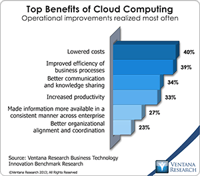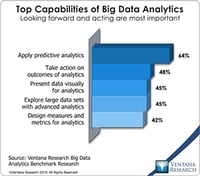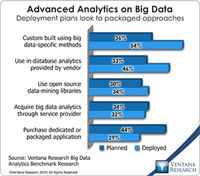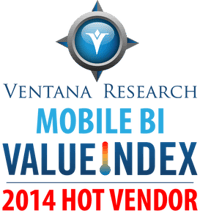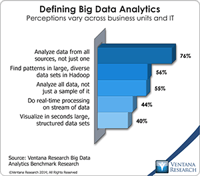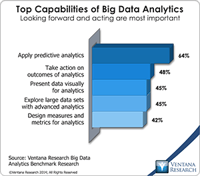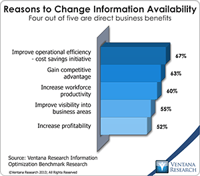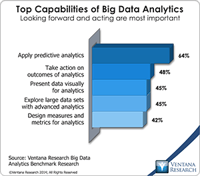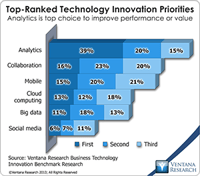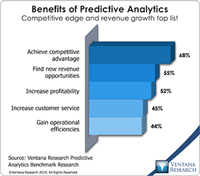It’s widely agreed that cloud computing is a major technology innovation. Many companies use cloud-based systems for specific business functions such as customer service, sales, marketing, finance and human resources. More generally, however, analytics and business intelligence (BI) have not migrated to the cloud as quickly. But now cloud-based data and analytics products are becoming more common. This trend is most popular among technology companies, small and midsize businesses, and...
Read More
Topics:
Big Data,
SaaS,
Sales Performance,
Social Media,
Governance,
Statistics,
cloud analytics,
IT Performance,
Analytics,
Business Analytics,
Business Intelligence,
Business Performance,
Cloud Computing,
Customer & Contact Center,
Data Integration,
Financial Performance,
Internet of Things,
Location Intelligence,
Operational Intelligence,
Workforce Performance,
Risk & Compliance (GRC),
cloud business intelligence
Our benchmark research consistently shows that business analytics is the most significant technology trend in business today and acquiring effective predictive analytics is organizations’ top priority for analytics. It enables them to look forward rather than backward and, participate organizations reported, leads to competitive advantage and operational efficiencies.
Read More
Topics:
Big Data,
Predictive Analytics,
Sales Performance,
Statistics,
IT Performance,
Operational Performance,
Analytics,
Business Analytics,
Business Collaboration,
Business Intelligence,
Business Performance,
Cloud Computing,
Customer & Contact Center,
Data Integration,
Financial Performance,
Governance, Risk & Compliance (GRC),
Information Applications,
Information Management,
Location Intelligence,
Operational Intelligence,
Workforce Performance
At its annual industry analyst summit last month and in a more recent announcement of enterprise support for parallelizing the R language on its Aster Discovery Platform, Teradata showed that it is adapting to changes in database and analytics technologies. The presentations at the conference revealed a unified approach to data architectures and value propositions in a variety of uses including the Internet of Things, digital marketing and ETL offloading. In particular, the company provided...
Read More
Topics:
Big Data,
Teradata,
IT Performance,
Operational Performance,
Business Analytics,
Business Intelligence,
Business Performance,
Customer & Contact Center,
Information Applications,
Information Management,
Internet of Things,
Operational Intelligence,
Teradata Aster
Read More
Topics:
Mobile,
IT Performance,
Operational Performance,
Analytics,
Business Analytics,
Business Intelligence,
Business Performance,
Customer & Contact Center,
Information Applications,
Information Builders,
Information Management,
Internet of Things,
Operational Intelligence,
InfoDiscovery
Teradata continues to expand its information management and analytics technology for big data to meet growing demand. My analysis last year discussed Teradata’s approach to big data in the context of its distributed computing and data architecture. I recently got an update on the company’s strategy and products at the annual Teradata analyst summit. Our big data analytics research finds that a broad approach to big data is wise: Three-quarters of organizations want analytics to access data from...
Read More
Topics:
Big Data,
Sales Performance,
Supply Chain Performance,
Teradata,
IT Performance,
Operational Performance,
Analytics,
Business Analytics,
Business Intelligence,
Business Performance,
Cloud Computing,
Customer & Contact Center,
Financial Performance,
Information Applications,
Information Management,
NoSQL,
Workforce Performance,
JSON,
UDA
Alteryx has released version 9.0 of Alteryx Analytics that provides a range of data to predictive analytics in advance of its annual user conference called Inspire 2014. I have covered the company for several years as it has emerged as a key player in providing a range of business analytics from predictive to big data analytics. The importance of this category of analytics is revealed by our latest benchmark research on big data analytics, which finds that predictive analytics is the most...
Read More
Topics:
Big Data,
Sales Performance,
Social Media,
Supply Chain Performance,
alteryx,
data blending,
IT Performance,
Operational Performance,
Analytics,
Business Analytics,
Business Intelligence,
Business Performance,
Customer & Contact Center,
Financial Performance,
Information Management,
Location Intelligence,
Operational Intelligence
I recently attended the 2014 global analyst summit in San Francisco hosted by Pitney Bowes, an old technology company (now in business for 94 years) that has a new focus in its software along with an entirely new executive team. These leaders unveiled a business and technology strategy meant to demonstrate the company’s commitment to software. For many years it has been known mostly for mail services and postage metering, but Pitney Bowes also has made investments in software that can help...
Read More
Topics:
Big Data,
Sales Performance,
Social Media,
Pitney Bowes,
IT Performance,
Operational Performance,
Business Analytics,
Business Intelligence,
Business Performance,
Cloud Computing,
Customer & Contact Center,
Information Applications,
Information Management,
Location Intelligence
Organizations should consider multiple aspects of deploying big data analytics. These include the type of analytics to be deployed, how the analytics will be deployed technologically and who must be involved both internally and externally to enable success. Our recent big data analytics benchmark research assesses each of these areas. How an organization views these deployment considerations may depend on the expected benefits of the big data analytics program and the particular business case...
Read More
Topics:
Big Data,
Predictive Analytics,
Sales Performance,
Social Media,
Supply Chain Performance,
IT Performance,
Operational Performance,
Analytics,
Business Analytics,
Business Collaboration,
Business Intelligence,
Business Performance,
Cloud Computing,
Customer & Contact Center,
Financial Performance,
Operational Intelligence,
Workforce Performance,
Strata+Hadoop
SAP recently presented its analytics and business intelligence roadmap and new innovations to about 1,700 customers and partners using SAP BusinessObjects at its SAP Insider event (#BI2014). SAP has one of the largest presences in business intelligence due to its installed base of SAP BusinessObjects customers. The company intends to defend its current position in the established business intelligence (BI) market while expanding in the areas of databases, discovery analytics and advanced...
Read More
Topics:
Predictive Analytics,
SAP,
Business Objects,
IT Performance,
Analytics,
Business Analytics,
Business Intelligence,
Business Performance,
Customer & Contact Center,
KXEN,
Operational Intelligence,
HANA,
Lumira,
SAP insider
SAS Institute, a long-established provider analytics software, showed off its latest technology innovations and product road maps at its recent analyst conference. In a very competitive market, SAS is not standing still, and executives showed progress on the goals introduced at last year’s conference, which I covered. SAS’s Visual Analytics software, integrated with an in-memory analytics engine called LASR, remains the company’s flagship product in its modernized portfolio. CEO Jim Goodnight...
Read More
Topics:
Predictive Analytics,
IT Performance,
LASR,
Operational Performance,
Analytics,
Business Analytics,
Business Intelligence,
Business Performance,
Cloudera,
Customer & Contact Center,
Hortonworks,
IBM,
Information Applications,
SAS institute,
Strata+Hadoop
